ACC5030 Module: Evaluating the Rational Approach to Strategy
VerifiedAdded on 2023/01/18
|8
|1696
|92
Report
AI Summary
This report critically evaluates the effectiveness of the rational approach to strategy, as required for the ACC5030 Strategic Development module. It begins by defining the rational model and explaining concepts like bounded rationality and Anthony's triangle. The report then details the advantages, such as informed decision-making and logical consistency, and disadvantages, including time constraints and inflexibility. It explores alternative strategic models, including emergent and incremental approaches, as well as freewheeling opportunism. The analysis assesses the rational approach's strengths and weaknesses, concluding with an overall evaluation of its efficacy in different contexts. The report includes references to support the arguments made.
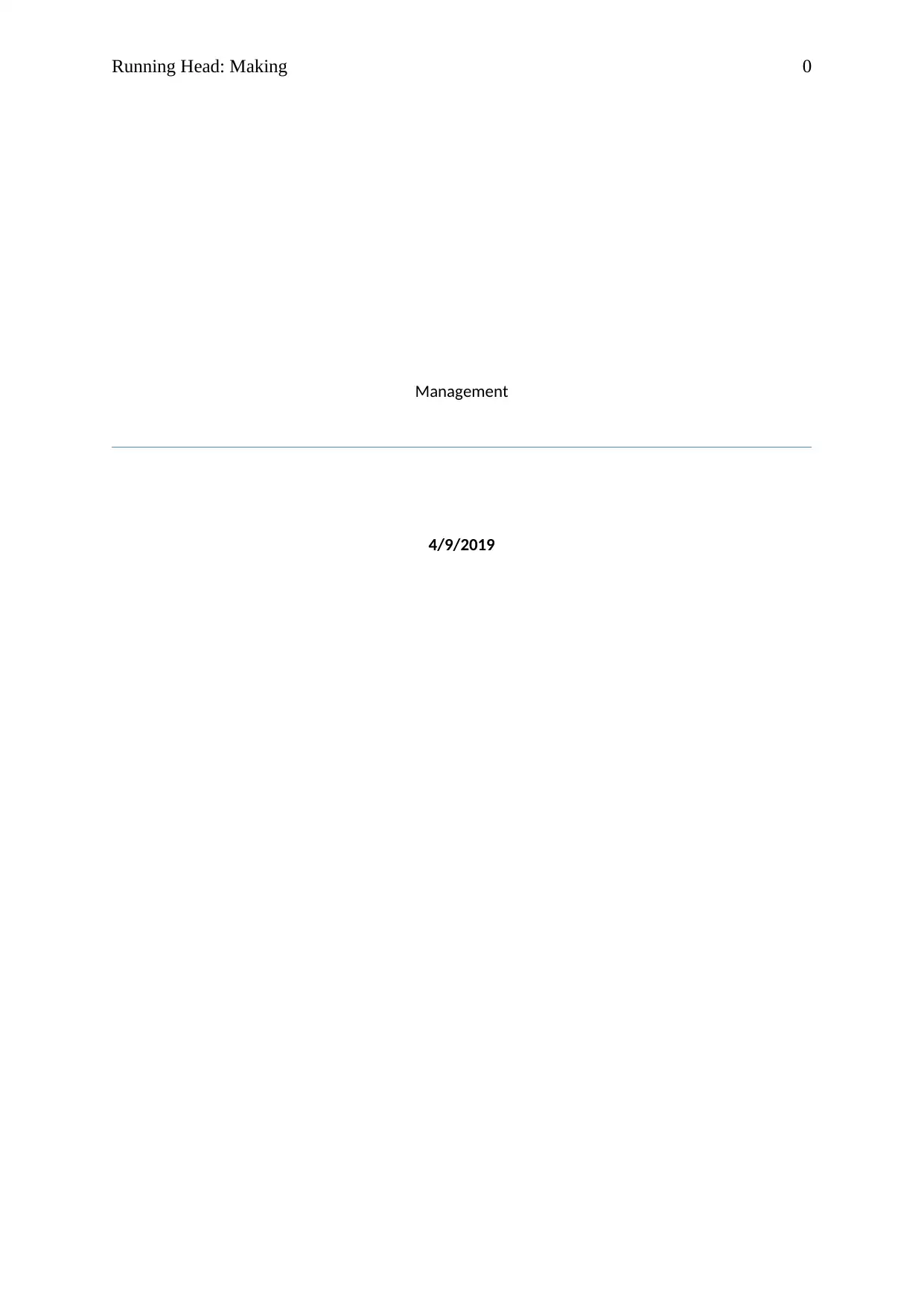
Running Head: Making 0
Management
4/9/2019
Management
4/9/2019
Paraphrase This Document
Need a fresh take? Get an instant paraphrase of this document with our AI Paraphraser
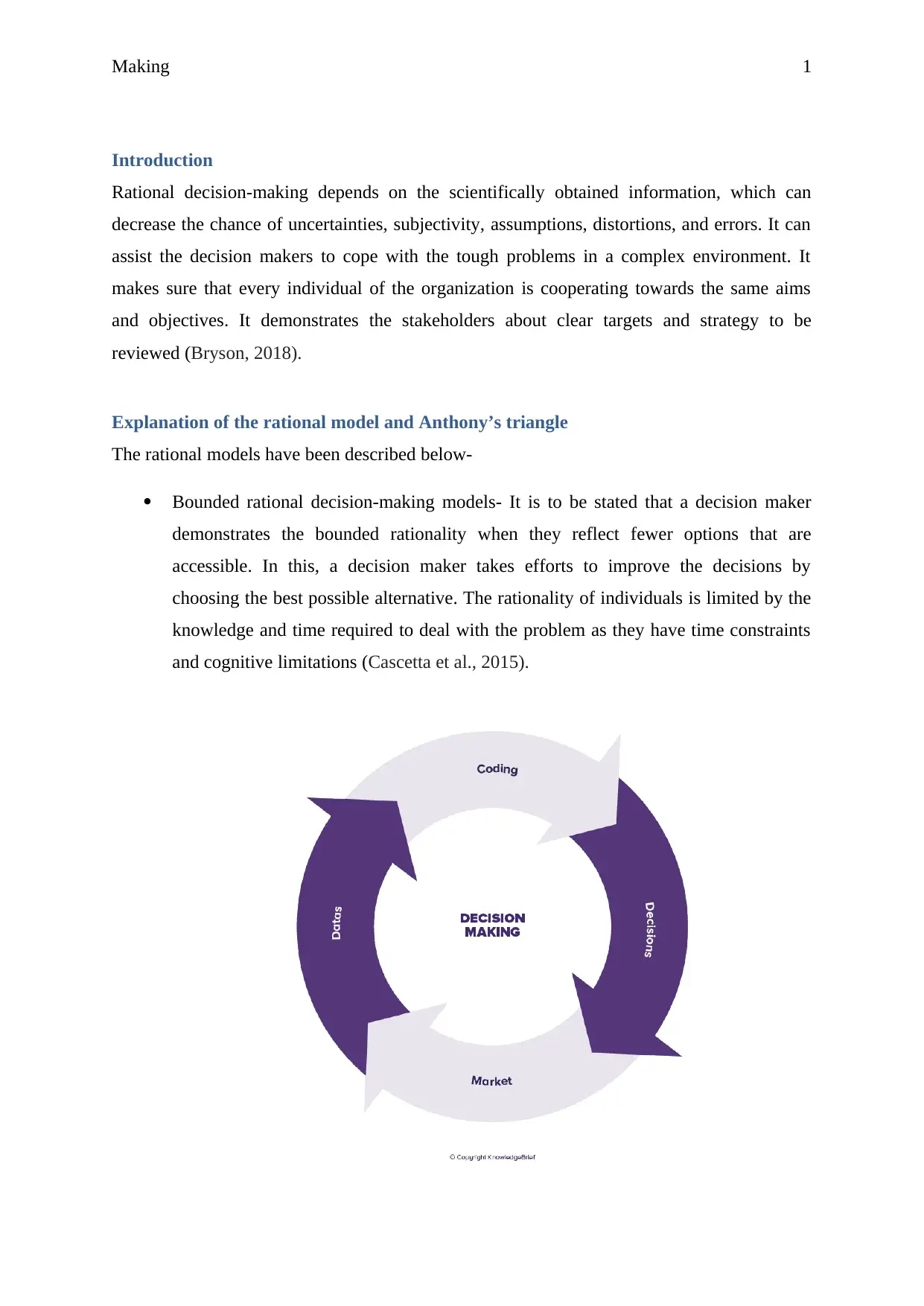
Making 1
Introduction
Rational decision-making depends on the scientifically obtained information, which can
decrease the chance of uncertainties, subjectivity, assumptions, distortions, and errors. It can
assist the decision makers to cope with the tough problems in a complex environment. It
makes sure that every individual of the organization is cooperating towards the same aims
and objectives. It demonstrates the stakeholders about clear targets and strategy to be
reviewed (Bryson, 2018).
Explanation of the rational model and Anthony’s triangle
The rational models have been described below-
Bounded rational decision-making models- It is to be stated that a decision maker
demonstrates the bounded rationality when they reflect fewer options that are
accessible. In this, a decision maker takes efforts to improve the decisions by
choosing the best possible alternative. The rationality of individuals is limited by the
knowledge and time required to deal with the problem as they have time constraints
and cognitive limitations (Cascetta et al., 2015).
Introduction
Rational decision-making depends on the scientifically obtained information, which can
decrease the chance of uncertainties, subjectivity, assumptions, distortions, and errors. It can
assist the decision makers to cope with the tough problems in a complex environment. It
makes sure that every individual of the organization is cooperating towards the same aims
and objectives. It demonstrates the stakeholders about clear targets and strategy to be
reviewed (Bryson, 2018).
Explanation of the rational model and Anthony’s triangle
The rational models have been described below-
Bounded rational decision-making models- It is to be stated that a decision maker
demonstrates the bounded rationality when they reflect fewer options that are
accessible. In this, a decision maker takes efforts to improve the decisions by
choosing the best possible alternative. The rationality of individuals is limited by the
knowledge and time required to deal with the problem as they have time constraints
and cognitive limitations (Cascetta et al., 2015).
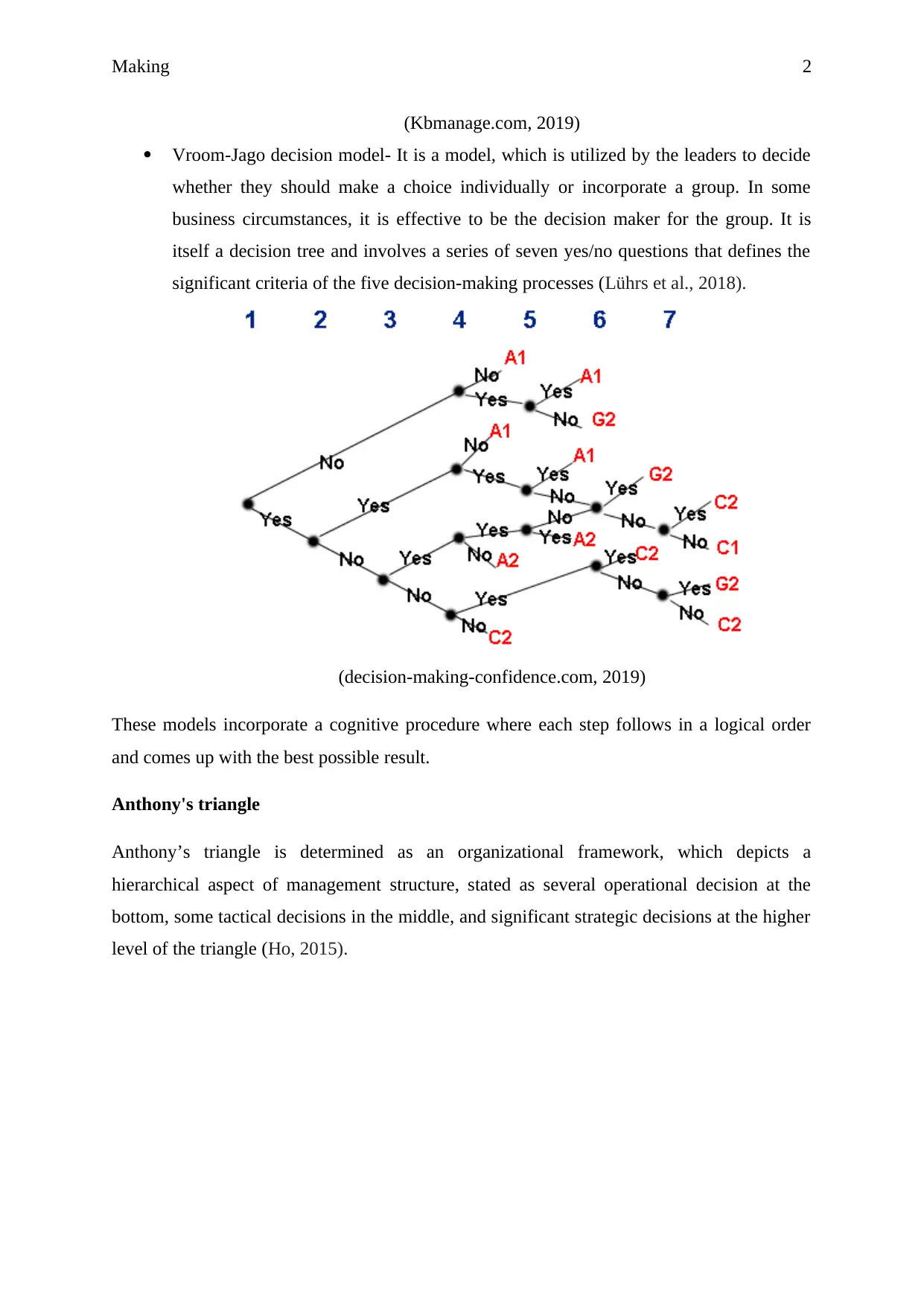
Making 2
(Kbmanage.com, 2019)
Vroom-Jago decision model- It is a model, which is utilized by the leaders to decide
whether they should make a choice individually or incorporate a group. In some
business circumstances, it is effective to be the decision maker for the group. It is
itself a decision tree and involves a series of seven yes/no questions that defines the
significant criteria of the five decision-making processes (Lührs et al., 2018).
(decision-making-confidence.com, 2019)
These models incorporate a cognitive procedure where each step follows in a logical order
and comes up with the best possible result.
Anthony's triangle
Anthony’s triangle is determined as an organizational framework, which depicts a
hierarchical aspect of management structure, stated as several operational decision at the
bottom, some tactical decisions in the middle, and significant strategic decisions at the higher
level of the triangle (Ho, 2015).
(Kbmanage.com, 2019)
Vroom-Jago decision model- It is a model, which is utilized by the leaders to decide
whether they should make a choice individually or incorporate a group. In some
business circumstances, it is effective to be the decision maker for the group. It is
itself a decision tree and involves a series of seven yes/no questions that defines the
significant criteria of the five decision-making processes (Lührs et al., 2018).
(decision-making-confidence.com, 2019)
These models incorporate a cognitive procedure where each step follows in a logical order
and comes up with the best possible result.
Anthony's triangle
Anthony’s triangle is determined as an organizational framework, which depicts a
hierarchical aspect of management structure, stated as several operational decision at the
bottom, some tactical decisions in the middle, and significant strategic decisions at the higher
level of the triangle (Ho, 2015).
⊘ This is a preview!⊘
Do you want full access?
Subscribe today to unlock all pages.

Trusted by 1+ million students worldwide
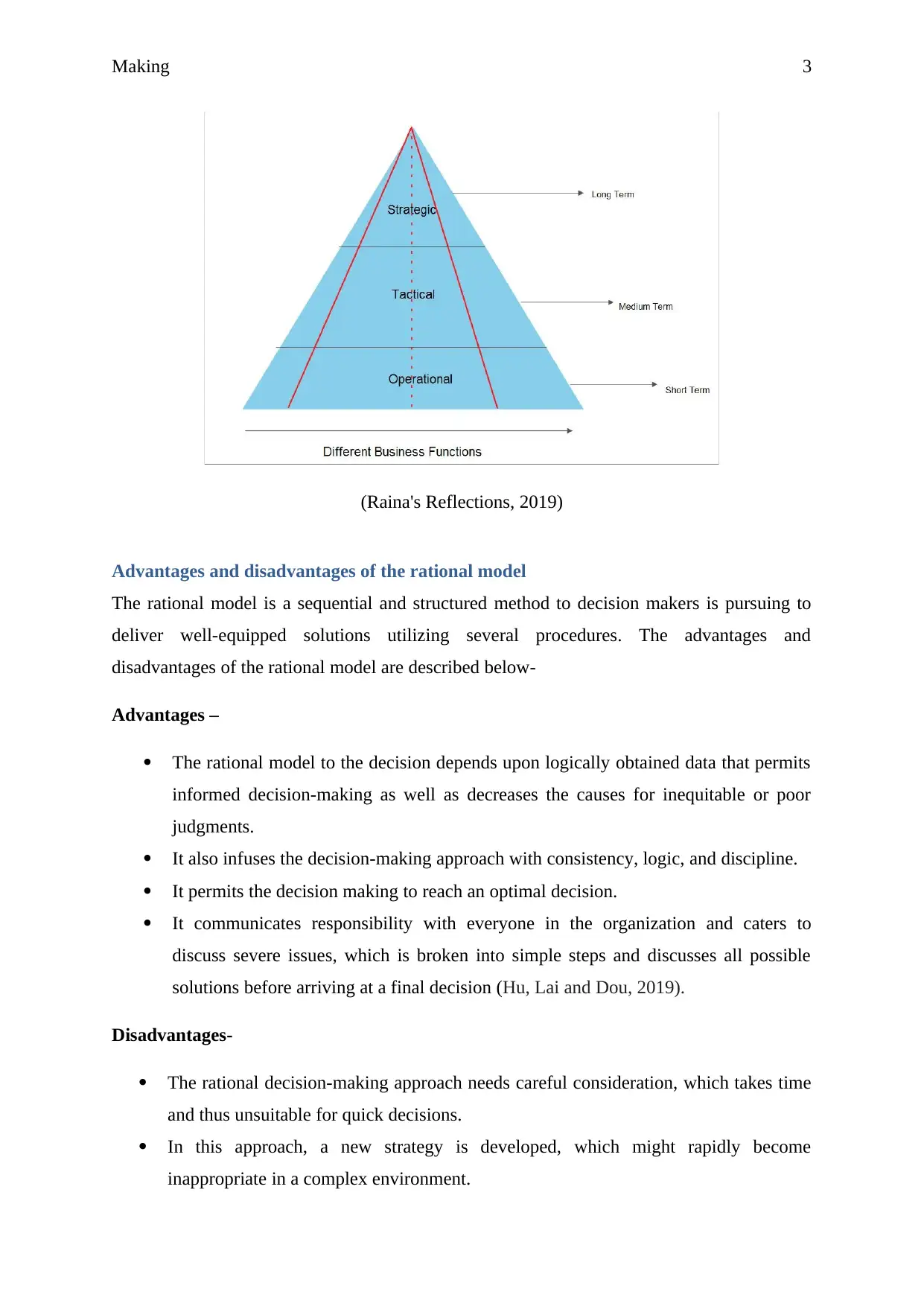
Making 3
(Raina's Reflections, 2019)
Advantages and disadvantages of the rational model
The rational model is a sequential and structured method to decision makers is pursuing to
deliver well-equipped solutions utilizing several procedures. The advantages and
disadvantages of the rational model are described below-
Advantages –
The rational model to the decision depends upon logically obtained data that permits
informed decision-making as well as decreases the causes for inequitable or poor
judgments.
It also infuses the decision-making approach with consistency, logic, and discipline.
It permits the decision making to reach an optimal decision.
It communicates responsibility with everyone in the organization and caters to
discuss severe issues, which is broken into simple steps and discusses all possible
solutions before arriving at a final decision (Hu, Lai and Dou, 2019).
Disadvantages-
The rational decision-making approach needs careful consideration, which takes time
and thus unsuitable for quick decisions.
In this approach, a new strategy is developed, which might rapidly become
inappropriate in a complex environment.
(Raina's Reflections, 2019)
Advantages and disadvantages of the rational model
The rational model is a sequential and structured method to decision makers is pursuing to
deliver well-equipped solutions utilizing several procedures. The advantages and
disadvantages of the rational model are described below-
Advantages –
The rational model to the decision depends upon logically obtained data that permits
informed decision-making as well as decreases the causes for inequitable or poor
judgments.
It also infuses the decision-making approach with consistency, logic, and discipline.
It permits the decision making to reach an optimal decision.
It communicates responsibility with everyone in the organization and caters to
discuss severe issues, which is broken into simple steps and discusses all possible
solutions before arriving at a final decision (Hu, Lai and Dou, 2019).
Disadvantages-
The rational decision-making approach needs careful consideration, which takes time
and thus unsuitable for quick decisions.
In this approach, a new strategy is developed, which might rapidly become
inappropriate in a complex environment.
Paraphrase This Document
Need a fresh take? Get an instant paraphrase of this document with our AI Paraphraser

Making 4
This approach utilizes mostly in making policy and long-term decisions despite
operational decisions.
Rational decision-making is steeped in traditionalism on the aspect of the carefulness
(McCabe, 2016).
Alternative models
Emergent view-
Mintzberg contends that successful and effective strategies can emerge in an enterprise
without deliberate and formal prior planning. Under this approach, a strategy might be tried
and established as it is executed. This is likely to result in a more short-term emphasis than
the rational model. It is stated that to effectively utilizes the emergent approach, the enterprise
needs to have a culture of innovation. The pattern is often made up of the intended strategies
and emergent strategies (Sims, Powell and Vidgen, 2016).
It is stated that strategy might be tried and developed as it is executed. Mintzberg was not
shocked at the failure of the intended strategies, which is to be fully realized as deliberate
strategies. The emergent strategy is a reaction to the unexpected emergencies and on the other
hand, the realized strategy is superior to the intended strategy (Shah et al., 2015).
Incremental approach
It is the concept of the setting a long-term strategy, which recommends that the enterprises
wish to move from position A to position B. The enterprise can take this move in one larger
step for which they can select incremental approach. Lindblom suggested that how
administrators ‘muddle through’ bold strategic initiative. He argued that it is unlikely to
perceive a strategic planner wisely to attain predetermined goals. The strategic choice takes
This approach utilizes mostly in making policy and long-term decisions despite
operational decisions.
Rational decision-making is steeped in traditionalism on the aspect of the carefulness
(McCabe, 2016).
Alternative models
Emergent view-
Mintzberg contends that successful and effective strategies can emerge in an enterprise
without deliberate and formal prior planning. Under this approach, a strategy might be tried
and established as it is executed. This is likely to result in a more short-term emphasis than
the rational model. It is stated that to effectively utilizes the emergent approach, the enterprise
needs to have a culture of innovation. The pattern is often made up of the intended strategies
and emergent strategies (Sims, Powell and Vidgen, 2016).
It is stated that strategy might be tried and developed as it is executed. Mintzberg was not
shocked at the failure of the intended strategies, which is to be fully realized as deliberate
strategies. The emergent strategy is a reaction to the unexpected emergencies and on the other
hand, the realized strategy is superior to the intended strategy (Shah et al., 2015).
Incremental approach
It is the concept of the setting a long-term strategy, which recommends that the enterprises
wish to move from position A to position B. The enterprise can take this move in one larger
step for which they can select incremental approach. Lindblom suggested that how
administrators ‘muddle through’ bold strategic initiative. He argued that it is unlikely to
perceive a strategic planner wisely to attain predetermined goals. The strategic choice takes

Making 5
place by relating potential alternatives against each other, which delivers effective outcome
(DeMatthews, Mungal and Carrola, 2015).
Freewheeling optimism
It is stated that it is the alternative to have a long-term strategic plan is having a little plan.
Freewheeling opportunism is an aspect that recommends that an enterprise does not require
formal business planning as it should always remain open to opportunities. It is described as a
term that is used to define the essentially reactive process of management as a choice for
strategic planning.
The effectiveness of the rational approach
It is to be stated that the rational approach is the most effective approach to offer the standard
for effective decision-making. It can be very useful when making a high-value decision that
can provide an advantage from the assistance of several tools, knowledge of experts, and
processes. It will fulfil the situations of the deductive completeness and logical consistency. It
also identifies and accesses the data and information that can enhance cooperation based on
the facts.
It is to be stated that the Bounded rationality model is the most significant part of the
outcome of decisions based on the method that is utilized in making decisions. As compared
to the emergent approach in Honda, this states that they are setting up a subsidiary to acquire
250cc and 350cc machines to current motorcycle enthusiasts (Mustafa et al., 2018).
Conclusion
In conclusion, it has been stated that rational decision-making is effective and profitable in
selecting the best alternative accessible. Their main objective is to arrive at a final decision,
which will decrease the cost and improve the benefits. In the above, the discussion has been
made on the Bounded rationality of decision-making that concentrates on the human mind
that evaluates and process the information that is accessible. It is evident that an incremental
approach also takes an effective part in strategic planning.
place by relating potential alternatives against each other, which delivers effective outcome
(DeMatthews, Mungal and Carrola, 2015).
Freewheeling optimism
It is stated that it is the alternative to have a long-term strategic plan is having a little plan.
Freewheeling opportunism is an aspect that recommends that an enterprise does not require
formal business planning as it should always remain open to opportunities. It is described as a
term that is used to define the essentially reactive process of management as a choice for
strategic planning.
The effectiveness of the rational approach
It is to be stated that the rational approach is the most effective approach to offer the standard
for effective decision-making. It can be very useful when making a high-value decision that
can provide an advantage from the assistance of several tools, knowledge of experts, and
processes. It will fulfil the situations of the deductive completeness and logical consistency. It
also identifies and accesses the data and information that can enhance cooperation based on
the facts.
It is to be stated that the Bounded rationality model is the most significant part of the
outcome of decisions based on the method that is utilized in making decisions. As compared
to the emergent approach in Honda, this states that they are setting up a subsidiary to acquire
250cc and 350cc machines to current motorcycle enthusiasts (Mustafa et al., 2018).
Conclusion
In conclusion, it has been stated that rational decision-making is effective and profitable in
selecting the best alternative accessible. Their main objective is to arrive at a final decision,
which will decrease the cost and improve the benefits. In the above, the discussion has been
made on the Bounded rationality of decision-making that concentrates on the human mind
that evaluates and process the information that is accessible. It is evident that an incremental
approach also takes an effective part in strategic planning.
⊘ This is a preview!⊘
Do you want full access?
Subscribe today to unlock all pages.

Trusted by 1+ million students worldwide

Making 6
References
Bryson, J.M. (2018) Strategic planning for public and nonprofit organizations: A guide to
strengthening and sustaining organizational achievement. U.S.A: John Wiley & Sons.
Cascetta, E., Carteni, A., Pagliara, F. and Montanino, M. (2015) A new look at planning and
designing transportation systems: A decision-making model based on cognitive rationality,
stakeholder engagement and quantitative methods. Transport policy, 38, pp.27-39.
decision-making-confidence.com. (2019). Vroom-Jago decision model - Learn how to quickly
run through it.. [online] Available at: https://www.decision-making-confidence.com/vroom-
jago-decision-model.html [Accessed 10 Apr. 2019].
DeMatthews, D.E., Mungal, A.S. and Carrola, P.A. (2015) Despite best intentions: A critical
analysis of social justice leadership and decision making. Administrative Issues Journal, 5(2),
p.3.
Ho, J.K.K. (2015) A review of frameworks for classification of information systems, notably
on the Anthony’s Triangle. European Academic Research, 3(1), pp.604-616.
Hu, C., Lai, S. and Dou, Z. (2019) On the study of a rational expectation model with lagged
endogenous variables. Journal of Difference Equations and Applications, 25(3), pp.351-372.
Kbmanage.com. (2019). Bounded Rationality Model of Decision-Making - What is it?
Definition, Examples and More. [online] Available at:
https://www.kbmanage.com/concept/bounded-rationality-model-of-decision-making
[Accessed 10 Apr. 2019].
Lührs, N., Jager, N.W., Challies, E. and Newig, J. (2018) How participatory should
environmental governance be? Testing the applicability of the vroom-Yetton-Jago model in
public environmental decision-making. Environmental management, 61(2), pp.249-262.
McCabe, D. (2016) ‘Curiouser and curiouser!’: Organizations as Wonderland–a metaphorical
alternative to the rational model. human relations, 69(4), pp.945-973.
Mustafa, M.B., Bistamam, M.N., Mohd, S., Jais, M.A.S.M.A. and Salim, S.S.S. (2018) The
Effect of Rational Emotive Behavior Therapy Approach Module in the Conflict Management
Of Guidance and. Social Sciences, 8(4), pp.923-932.
References
Bryson, J.M. (2018) Strategic planning for public and nonprofit organizations: A guide to
strengthening and sustaining organizational achievement. U.S.A: John Wiley & Sons.
Cascetta, E., Carteni, A., Pagliara, F. and Montanino, M. (2015) A new look at planning and
designing transportation systems: A decision-making model based on cognitive rationality,
stakeholder engagement and quantitative methods. Transport policy, 38, pp.27-39.
decision-making-confidence.com. (2019). Vroom-Jago decision model - Learn how to quickly
run through it.. [online] Available at: https://www.decision-making-confidence.com/vroom-
jago-decision-model.html [Accessed 10 Apr. 2019].
DeMatthews, D.E., Mungal, A.S. and Carrola, P.A. (2015) Despite best intentions: A critical
analysis of social justice leadership and decision making. Administrative Issues Journal, 5(2),
p.3.
Ho, J.K.K. (2015) A review of frameworks for classification of information systems, notably
on the Anthony’s Triangle. European Academic Research, 3(1), pp.604-616.
Hu, C., Lai, S. and Dou, Z. (2019) On the study of a rational expectation model with lagged
endogenous variables. Journal of Difference Equations and Applications, 25(3), pp.351-372.
Kbmanage.com. (2019). Bounded Rationality Model of Decision-Making - What is it?
Definition, Examples and More. [online] Available at:
https://www.kbmanage.com/concept/bounded-rationality-model-of-decision-making
[Accessed 10 Apr. 2019].
Lührs, N., Jager, N.W., Challies, E. and Newig, J. (2018) How participatory should
environmental governance be? Testing the applicability of the vroom-Yetton-Jago model in
public environmental decision-making. Environmental management, 61(2), pp.249-262.
McCabe, D. (2016) ‘Curiouser and curiouser!’: Organizations as Wonderland–a metaphorical
alternative to the rational model. human relations, 69(4), pp.945-973.
Mustafa, M.B., Bistamam, M.N., Mohd, S., Jais, M.A.S.M.A. and Salim, S.S.S. (2018) The
Effect of Rational Emotive Behavior Therapy Approach Module in the Conflict Management
Of Guidance and. Social Sciences, 8(4), pp.923-932.
Paraphrase This Document
Need a fresh take? Get an instant paraphrase of this document with our AI Paraphraser
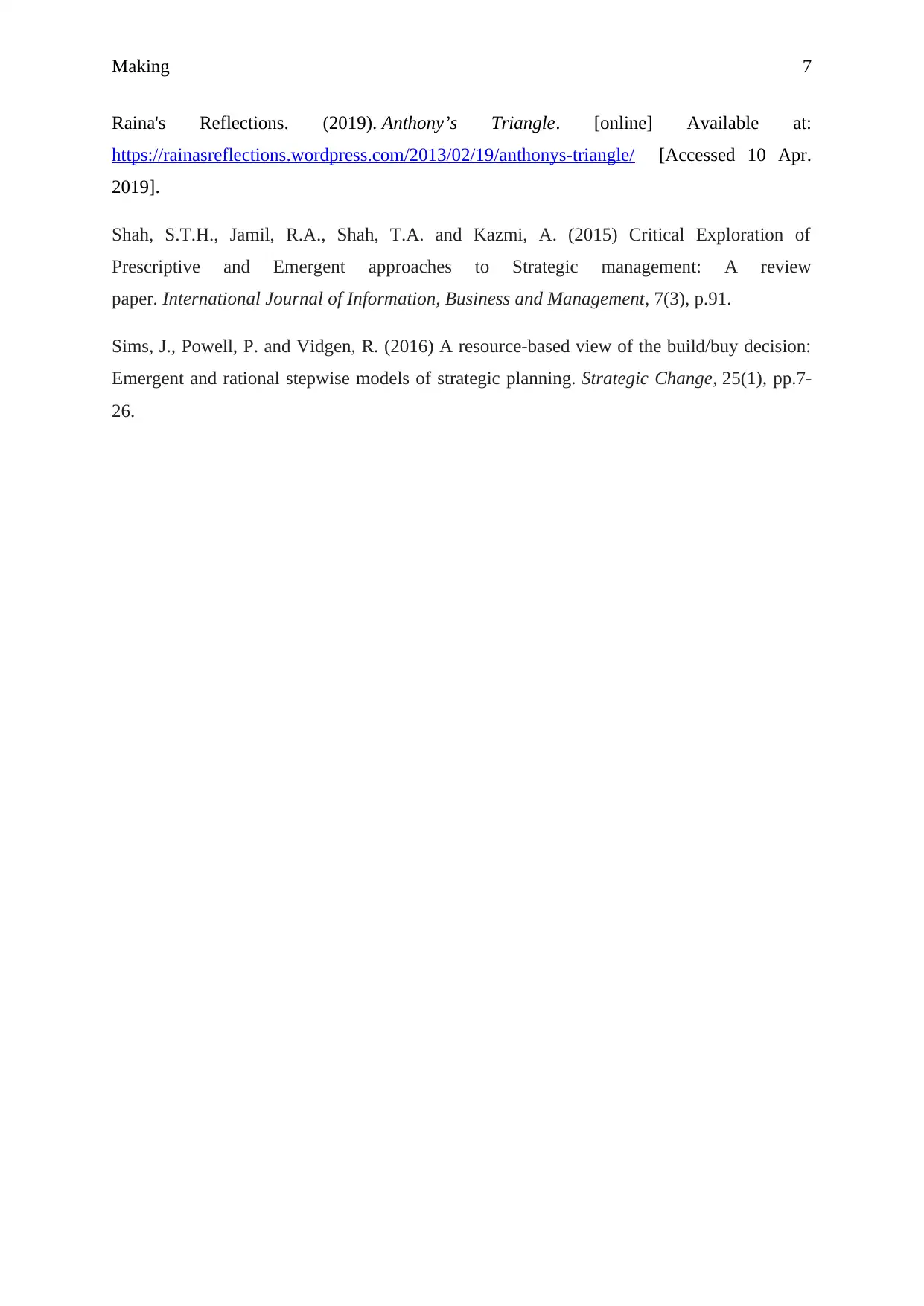
Making 7
Raina's Reflections. (2019). Anthony’s Triangle. [online] Available at:
https://rainasreflections.wordpress.com/2013/02/19/anthonys-triangle/ [Accessed 10 Apr.
2019].
Shah, S.T.H., Jamil, R.A., Shah, T.A. and Kazmi, A. (2015) Critical Exploration of
Prescriptive and Emergent approaches to Strategic management: A review
paper. International Journal of Information, Business and Management, 7(3), p.91.
Sims, J., Powell, P. and Vidgen, R. (2016) A resource‐based view of the build/buy decision:
Emergent and rational stepwise models of strategic planning. Strategic Change, 25(1), pp.7-
26.
Raina's Reflections. (2019). Anthony’s Triangle. [online] Available at:
https://rainasreflections.wordpress.com/2013/02/19/anthonys-triangle/ [Accessed 10 Apr.
2019].
Shah, S.T.H., Jamil, R.A., Shah, T.A. and Kazmi, A. (2015) Critical Exploration of
Prescriptive and Emergent approaches to Strategic management: A review
paper. International Journal of Information, Business and Management, 7(3), p.91.
Sims, J., Powell, P. and Vidgen, R. (2016) A resource‐based view of the build/buy decision:
Emergent and rational stepwise models of strategic planning. Strategic Change, 25(1), pp.7-
26.
1 out of 8
Related Documents
Your All-in-One AI-Powered Toolkit for Academic Success.
+13062052269
info@desklib.com
Available 24*7 on WhatsApp / Email
![[object Object]](/_next/static/media/star-bottom.7253800d.svg)
Unlock your academic potential
Copyright © 2020–2025 A2Z Services. All Rights Reserved. Developed and managed by ZUCOL.





